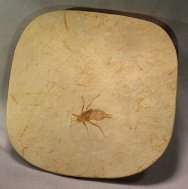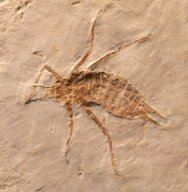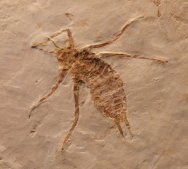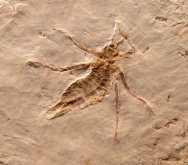Nothomacromia
sensibilis
Insect
Order Odonata, Family Nothomacromiidae
Geological
Time: Lower Cretaceous, Late Aptian-Cenomanian (108-92 million
years ago)
Size (25.4
mm = 1 inch): Insect fossil overall length 25 mm; Matrix: 95 mm by 100
mm
Fossil Site:
Crato Formation, Nova Olinda Member, Ceara, Brazil
Fossil Code:
BI75
Price: Sold
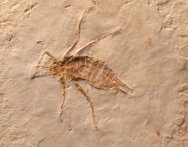 Description:
The Araripe Basin of Brazil is home to a fantastic array of exquisitely-detailed
Early Cretaceous fossils, some of which have been preserved in
three dimensions. While the entire formation has until the last
decade or so been termed the Santana Formation, David Martill has
separated out the slightly older insect-bearing strata as the Nova
Olinda Member of the Crato Formation. Quarrying operations for
the purposes of obtaining paving stones exposes the remarkable
insect fauna in much the same way that quarrying for lithographic
limestone in Solnhofen has afforded a panoply of wonderfully-preserved
Jurassic fossils in Germany. In addition to the many orders of
insects, spiders, scorpions, decapod crustaceans, and many plants
have been found. Interestingly, to date no pterosaurs or terrestrial
vertebrates have been found, in stark contrast to the overlying
Santana Formation deposits. This specimen is a member of the Odonata
(dragonflies and damselflies). The Odonata a re well-represented
in the fossil record, with some 700 species known. They have their
origin in the proto-Odonates from the Carboniferous. Meganeuropsis
from the Permian of North America, with a 75 cm wingspan, was the
largest insect on record. This fine dragonfly nymph is known as
Notomacromia sensibilis. When first discovered, the researchers
described it as a possible coptoclavid beetle with the whimsical
name Conan barbarica. Dragonflies from these deposits are always
popular with collectors. Interestingly, the larvae are considerably
harder to obtain. While I typically see as many as five adult dragonflies
offered at the Tucson show, this is the ONLY nymph I have seen
in the last 5 years. Description:
The Araripe Basin of Brazil is home to a fantastic array of exquisitely-detailed
Early Cretaceous fossils, some of which have been preserved in
three dimensions. While the entire formation has until the last
decade or so been termed the Santana Formation, David Martill has
separated out the slightly older insect-bearing strata as the Nova
Olinda Member of the Crato Formation. Quarrying operations for
the purposes of obtaining paving stones exposes the remarkable
insect fauna in much the same way that quarrying for lithographic
limestone in Solnhofen has afforded a panoply of wonderfully-preserved
Jurassic fossils in Germany. In addition to the many orders of
insects, spiders, scorpions, decapod crustaceans, and many plants
have been found. Interestingly, to date no pterosaurs or terrestrial
vertebrates have been found, in stark contrast to the overlying
Santana Formation deposits. This specimen is a member of the Odonata
(dragonflies and damselflies). The Odonata a re well-represented
in the fossil record, with some 700 species known. They have their
origin in the proto-Odonates from the Carboniferous. Meganeuropsis
from the Permian of North America, with a 75 cm wingspan, was the
largest insect on record. This fine dragonfly nymph is known as
Notomacromia sensibilis. When first discovered, the researchers
described it as a possible coptoclavid beetle with the whimsical
name Conan barbarica. Dragonflies from these deposits are always
popular with collectors. Interestingly, the larvae are considerably
harder to obtain. While I typically see as many as five adult dragonflies
offered at the Tucson show, this is the ONLY nymph I have seen
in the last 5 years. |
|

